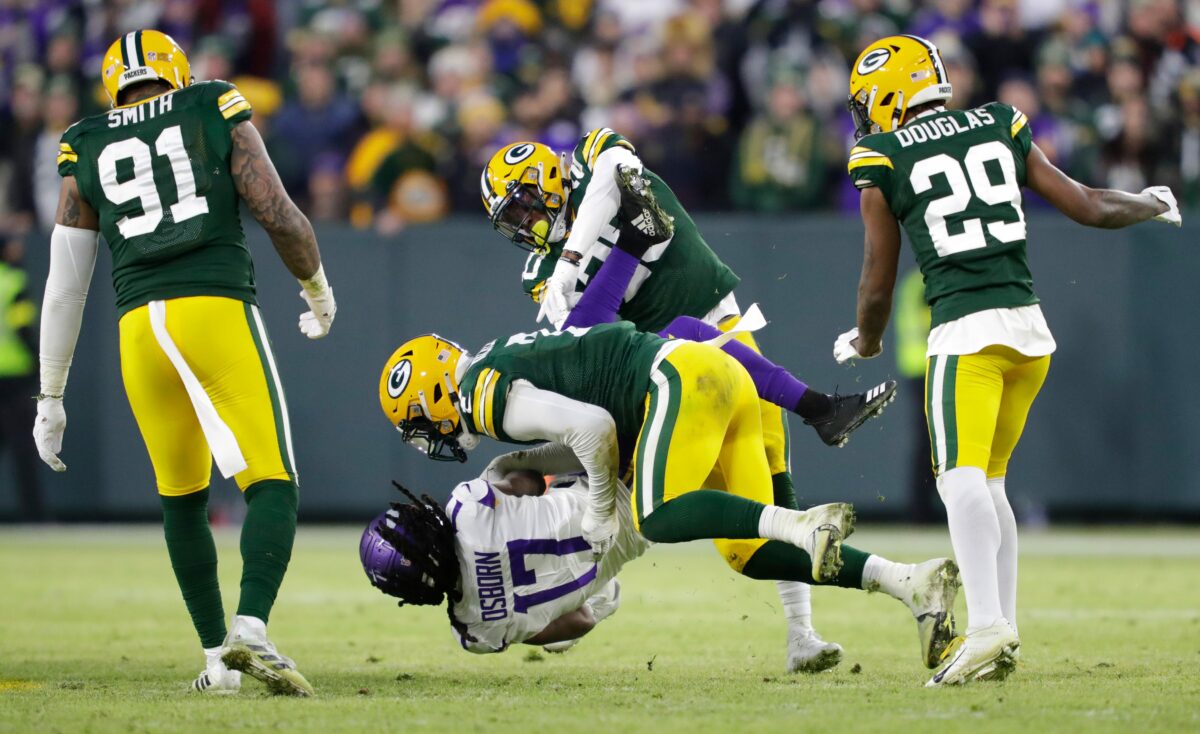What started as a joke in training camp might actually be true heading into the final week of the regular season. The Green Bay Packers are looking like a defensive football team despite having the two-time reigning MVP at quarterback.
“We’re a defensive team now,” Aaron Rodgers said jokingly back in July. “It’s one of the best defenses on paper that we’ve had.”
At the time, Rodgers fully expected the offense to get their butts whipped most days on the practice field. For the most part, that turned out to be true as the offense adjusted to life without Davante Adams while dealing with injuries.
Meanwhile, the Packers possessed what appeared to be a complete defense featuring seven first-round picks. But when the regular season officially kicked off against the Minnesota Vikings, they learned that games aren’t won on paper.
Coverage breakdowns and miscommunication allowed Vikings receiver Justin Jefferson to explode for 184 yards and two touchdowns in a 16-point defeat. The atrocious performance of Green Bay’s defense was head-scratching to say the least, judging by the talent at their disposal. Unfortunately, this was only the beginning of the disappointment.
The Packers would go on a five-game losing streak mid-way through the season, watching a defense fail to carry a struggling offense while allowing 23.8 points per game over that stretch.
Green Bay would be revitalized by an overtime win over the Dallas Cowboys in week 10, but only for a moment. They would lose their next two games by allowing Tennessee’s Ryan Tannehill to dice them up before Philadelphia’s Jalen Hurts rushed for a franchise record 157 yards by a quarterback.
Sitting at 4-8, everyone wanted answers. Specifically, as to why the defense was playing so poorly.
Frustration had settled over Joe Barry’s scheme, which didn’t appear to be making weekly adjustments to change its predicament. Many called for his firing, but rather than part ways with his defensive coordinator midseason, Matt LaFleur declined to single anyone out, instead putting the onus on everyone, including the players.
“It’s never just one person,” said LaFleur. “It starts with myself, and then it goes to our assistant coaches and then our players. We’re all in this together. If I felt confident it was one person, then I’d pinpoint it.”
Then, Barry’s defense started to do something it had failed to do most of the season: create turnovers. Through the first 12 games of the season, the Packers had forced 12 turnovers. Over the last four games, they have matched the total.
It started in Week 13 with a confidence-boosting win over the 3-10 Chicago Bears. After scoring a late touchdown to go up 26-19, corner Keisean Nixon ended the game with his first career interception.
Following a bye week, Rams quarterback Baker Mayfield would throw a costly interception to Rasul Douglas with his team down 12 points at the beginning of the fourth quarter. That led to a visit to Miami on Christmas Day, where Tua Tagovailoa threw three second-half interceptions and allowed Green Bay to escape with a 26-20 win.
The next opponent would be the same offense led by Jefferson in accumulating 395 yards at the start of the season. Unfortunately for Minnesota, it wouldn’t be the same defense.
The game started with a 105-yard touchdown return from Nixon and then a 75-yard pick-six from Darnell Savage. Before the Packers’ offense ever took the field, they had a double-digit lead.
For the rest of the game, Barry’s defense had adjusted to the NFL’s leading receiver, including putting Jaire Alexander on him for most of the game and rolling coverages in his direction to provide plenty of help. Not being able to rely on his top target, Kirk Cousins threw three interceptions and was strip-sacked by Kenny Clark, who also recovered the fumble.
During their four-game win streak, Green Bay’s defense has forced nine interceptions and three fumbles. They are also allowing an improved 17 points per game, and the coverage and communication miscues that plagued this unit earlier in the year have been far less prevalent.
“Guys are playing off one another. Certainly, communication is a big part of getting everybody on the same page and being able to go out there and execute, but I think our guys are just playing a lot better and with a lot more passion,” LaFleur said Monday.
Meanwhile, the offense has done a good job of not relying on the heroic play of their Hall of Fame quarterback that was needed in previous years. Over the last four games, the Packers have struck a good balance between their run and pass game, averaging 202 passing yards per game compared to nearly 139 yards per game on the ground.
As a nice change, Rodgers doesn’t burden the responsibility of making all the plays. He has yet to throw for 300 yards in a game this season and will likely finish with the lowest passing yard total in his career after starting in every game. To make up the difference, his defense is producing turnovers at an incredible rate, thus making things much easier on an offense that can focus on staying efficient.
For now, Rodgers no longer carries the weight of the offense, and the offense no longer carries the weight of the Packers. All the talk over the summer about Green Bay being a defensive football team may have finally come to fruition.
[mm-video type=playlist id=01eqbxb1xg7g19wqdc player_id=01eqbvhghtkmz2182d image=]
